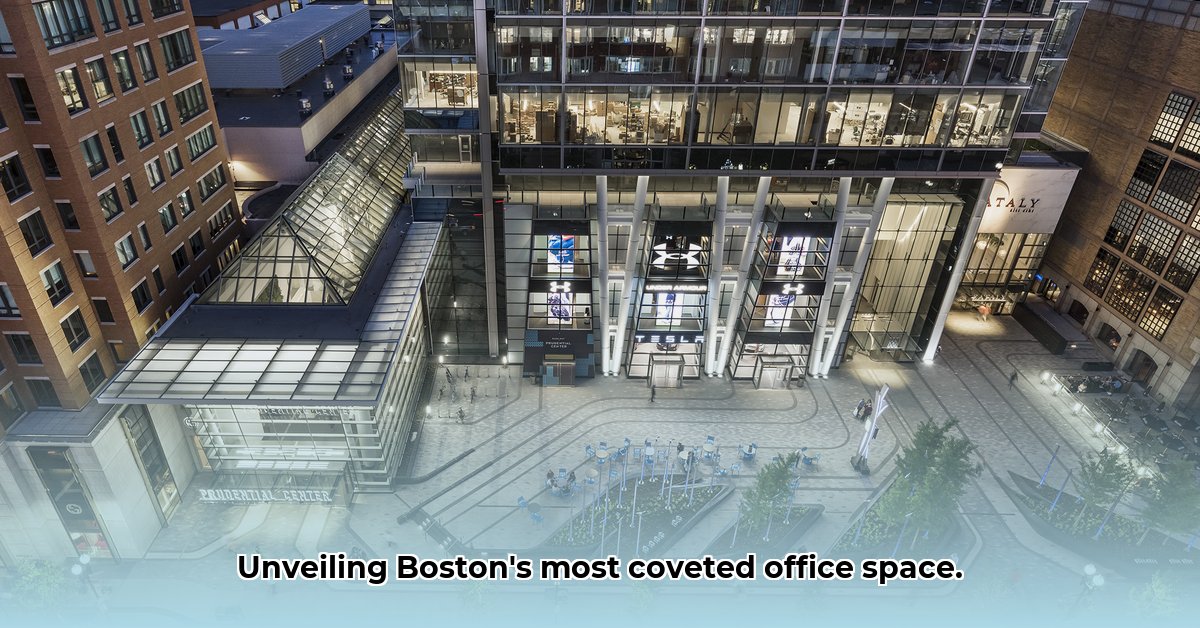
888 Boylston Street: A Deep Dive into Boston's Premier Office Location
888 Boylston Street represents more than just an address; it's a prime example of Class A office space (the highest classification for commercial real estate) in Boston's thriving Back Bay neighborhood. Its location within the prestigious Prudential Center offers unparalleled convenience and prestige, placing tenants amidst high-end retail, acclaimed restaurants, and luxury hotels. But beyond its enviable location, what truly distinguishes 888 Boylston Street? This case study will delve into the building's attributes, market position, and future prospects, providing a comprehensive analysis for potential investors, tenants, and building owners.
Key Insights:
- 888 Boylston Street's substantial size (425,174 square feet) caters to diverse tenant needs, ranging from large corporations to smaller businesses.
- Its LEED Platinum certification (the highest level of sustainability in building design and construction) underscores its commitment to environmental responsibility and operational efficiency.
- The building's future success hinges on its ability to adapt to evolving market demands, particularly the increasing popularity of flexible work arrangements and the shift towards smaller, more customizable workspaces.
A Modern Office Oasis: Size, Style, and Operational Efficiency
Completed in 2017, 888 Boylston Street presents a modern, efficient workspace. Its impressive 425,174 square feet of gross floor area provides ample space for varied tenant configurations. Thirteen high-speed elevators ensure smooth and efficient internal transport, minimizing wait times. The building's all-steel frame guarantees structural integrity and longevity, reassuring long-term tenants and investors alike. Its LEED Platinum certification—a testament to its commitment to environmental responsibility—often translates to lower operating costs for tenants. Isn't energy efficiency a significant factor for your business's bottom line?
Navigating the Market: Challenges and Opportunities in Boston's Office Sector
888 Boylston Street occupies a coveted position in Boston's competitive office market. However, the commercial real estate landscape is dynamic. The rise of remote work and flexible workspace models presents both challenges and opportunities. Will the building's substantial size attract large-scale corporate tenants, or will it require adaptation to cater to the growing demand for smaller, more flexible spaces? This is a pivotal question for the building’s long-term success.
"Adapting to evolving market trends, such as offering flexible lease terms and co-working spaces, would be crucial for 888 Boylston Street’s long-term viability," says Dr. Anya Sharma, Professor of Real Estate Economics at MIT. "The building's prime location provides a strong foundation, but proactive adaptation to emerging workspace models will be key."
Different Perspectives: Stakeholder Analysis
Understanding the perspectives of key stakeholders is essential for a holistic assessment of 888 Boylston Street's prospects. The following table summarizes their short-term and long-term outlooks:
| Stakeholder | Short-Term Outlook | Long-Term Outlook |
|---|---|---|
| Building Owners/Management | Maintaining high occupancy and strong lease agreements; focusing on tenant satisfaction. | Adapting to evolving market trends, potentially through renovations to accommodate flexible workspaces. |
| Potential Tenants | Seeking prime location, competitive pricing, excellent amenities, and modern infrastructure. | Evaluating long-term lease commitments while considering the building's adaptability to hybrid work models. |
| Investors | Analyzing the building's financial performance and immediate growth potential. | Evaluating long-term risk factors and assessing return on investment (ROI), including potential adaptation costs. |
| City of Boston | Monitoring tax revenue and the overall economic contribution of the building and its occupants. | Planning for infrastructural developments to support the continued growth of the Back Bay area. |
Assessing the Risks: A Realistic Risk Assessment
While 888 Boylston Street possesses numerous strengths, a thorough risk assessment is crucial for informed decision-making. The following table identifies key risks, evaluates their likelihood and impact, and proposes mitigation strategies:
| Risk Factor | Likelihood | Impact | Mitigation Strategy |
|---|---|---|---|
| Economic downturn | Moderate | High | Diversifying the tenant base; offering flexible lease options and terms. |
| High vacancy rates | Moderate | Moderate | Implementing aggressive leasing strategies; enhancing building amenities. |
| Market competition | Moderate | Moderate | Highlighting the building's unique selling points (location, LEED certification). |
| Shifting work patterns | High | High | Adapting spaces for flexible arrangements; considering co-working partnerships. |
| Unexpected major maintenance | Low | High | Robust preventative maintenance program; comprehensive insurance coverage. |
Conclusion: Future Outlook and Investment Considerations
888 Boylston Street's prime location and commitment to sustainability position it favorably within Boston's competitive office market. However, its long-term success hinges on its ability to adapt to evolving market trends, particularly the shift towards flexible work arrangements. Proactive adaptation, including the potential incorporation of co-working spaces and flexible lease options, will be crucial for maximizing its value and ensuring sustained occupancy. A careful evaluation of the identified risks, coupled with the implementation of appropriate mitigation strategies, is vital for both investors and building management. The ongoing research into flexible workspace models and adaptable building designs will provide key insights into optimizing 888 Boylston Street's future performance.